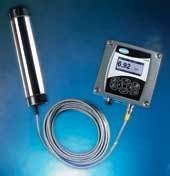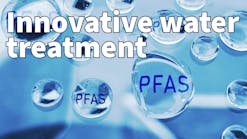Auburn staff uses a portable Hach HQ40d® meter with an LDO IntelliCALTM probe to verify the process instrument.
Click here to enlarge imageAfter careful evaluation, the Auburn plant installed a Hach LDO® process probe at the outfall, and began using a portable Hach HQ40d® meter with an LDO IntelliCALTM probe to verify the process instrument. LDO sensor technology was chosen because of its considerably longer life compared to that of traditional sensor technologies. In addition, there are no membranes or electrolyte solutions to replace and the calibration and maintenance frequency is lower.
Tier One Approval
EPA’s Analytical Support Branch recommends Hach LDO Method 10360 for the measurement of DO and the determination of biochemical oxygen demand (BOD) in wastewater effluent. However, before the process LDO unit could be used for monitoring and reporting at the Auburn plant, Tier One review and approval from EPA’s Region 5 were necessary.
“Region 5 wanted a SOP (Standard Operating Procedures) specific to the plant, which was basically taken from the Hach LDO Method 10360,” Schroeder said. “We were also required to complete a data comparison study.”
The data comparison study was run in about two hours using the portable HQ40d meter and process LDO probe to calibrate with the laboratory instrument and also for the calibration verification value that was listed in the SOP.
“Then, we took the portable unit out to the outfall and compared readings with the process unit installed there,” she said. “We felt that it made better sense to use the portable LDO unit for verification of the process unit rather than cart the process unit back and forth to the lab for verification, or take a sample of lab water out to our outfall and place the process probe in the sample for verification.”
Upon the completion and review of the study, the plant received regulatory approval to use the portable and process LDO probe readings for monitoring and reporting effluent DO. Schroeder said she received substantial support from the instrument manufacturer as far as providing statistical data and advice regarding what was required for regulatory policy.
After several months of trouble-free operation, Schroeder said that the new automated procedure is working as planned.
“Both the process and field LDO® instruments are performing very well. They are such consistent units, compared to the membrane probe we had been using. There had been a lot of variability with that unit, a lot of interferences.”
Schroeder said the process LDO probe installed at the plant’s outfall produces consistent values that are within 0.05 Standard units (SU) of the portable meter.
The process LDO probe is continuously read by a Hach sc100® controller that communicates via a 4-20 mA signal to the lab’s server. The controller has a built-in data logger that collects measurements at user selected intervals (1 to 30 minutes). The multi-parameter controller is designed to receive data from up to two sensors simultaneously, providing the plant flexibility for adding a second LDO probe later or for gaining broader parameter measurements, such as pH, or ORP, by simply plugging in the appropriate probe.
In addition to its use for verification of the process LDO unit, the lab also uses the portable LDO unit once a day to measure DO levels in the plant’s aeration tanks for process monitoring and control.
“The handheld HQ40d meter and IntelliCAL LDO probe is definitely more stable than the membrane DO probe we had been using. We no longer see the fluctuations in the values,” Schroeder said.
Although the Auburn lab is currently using the portable meter to measure DO, the HQd meter can take up to two simultaneous measurements of pH, conductivity, or LDO by connecting additional plug and play IntelliCALTM probes.
Schroeder said the unit has been maintenance free.
“With our old membrane probe we had to change out the membrane weekly. But with the portable Hach unit, all we need to do is change out the batteries once in a while.”
Schroeder said that a significant burden has been lifted with the adoption of online LDO monitoring and reporting. Auburn staff feels confident in the measurements they are reporting - especially since they are using the portable LDO instrument for verification. She estimates the lab is saving approximately 400 man-hours a year using this procedure.
About the Authors:
Cary Jackson, PhD, is the Director of Regulatory Affairs for Hach Company. Robbin Crane is the Vertical Market Specialist for Wastewater in Hach’s Corporate Marketing Department. Both can be reached at Hach’s headquarters in Loveland, Colorado.




